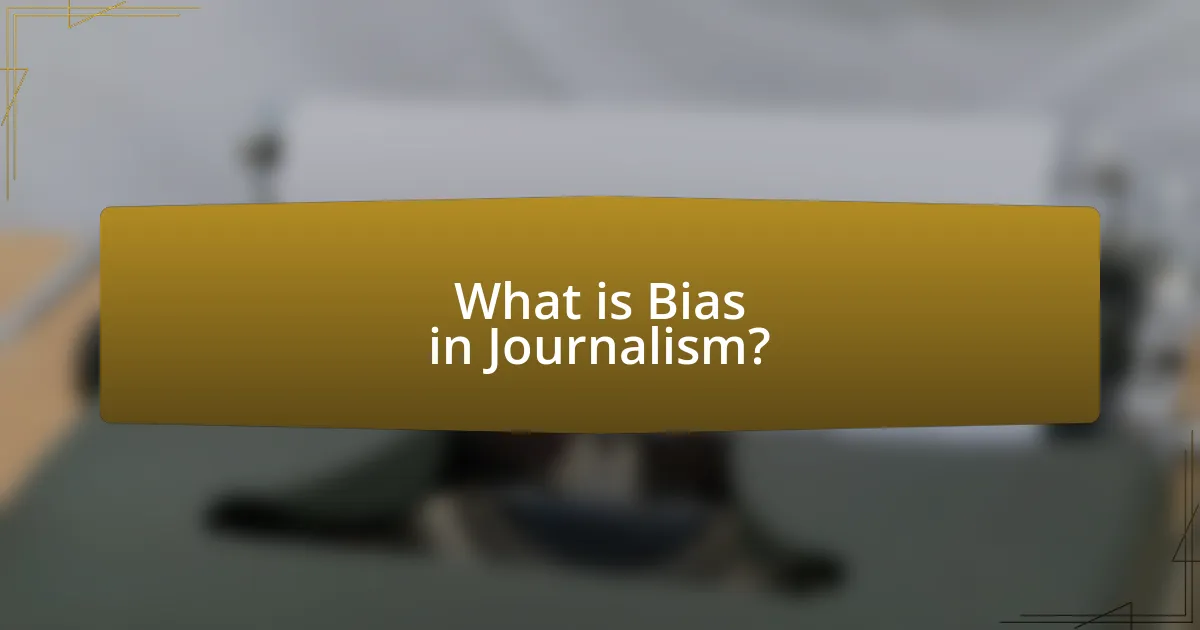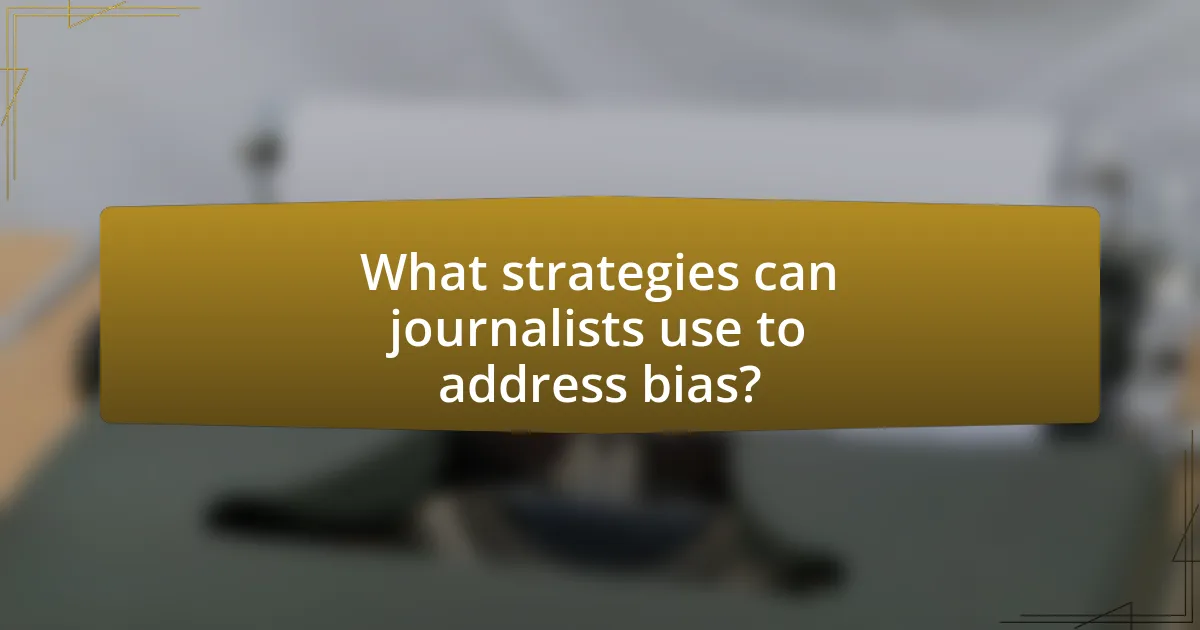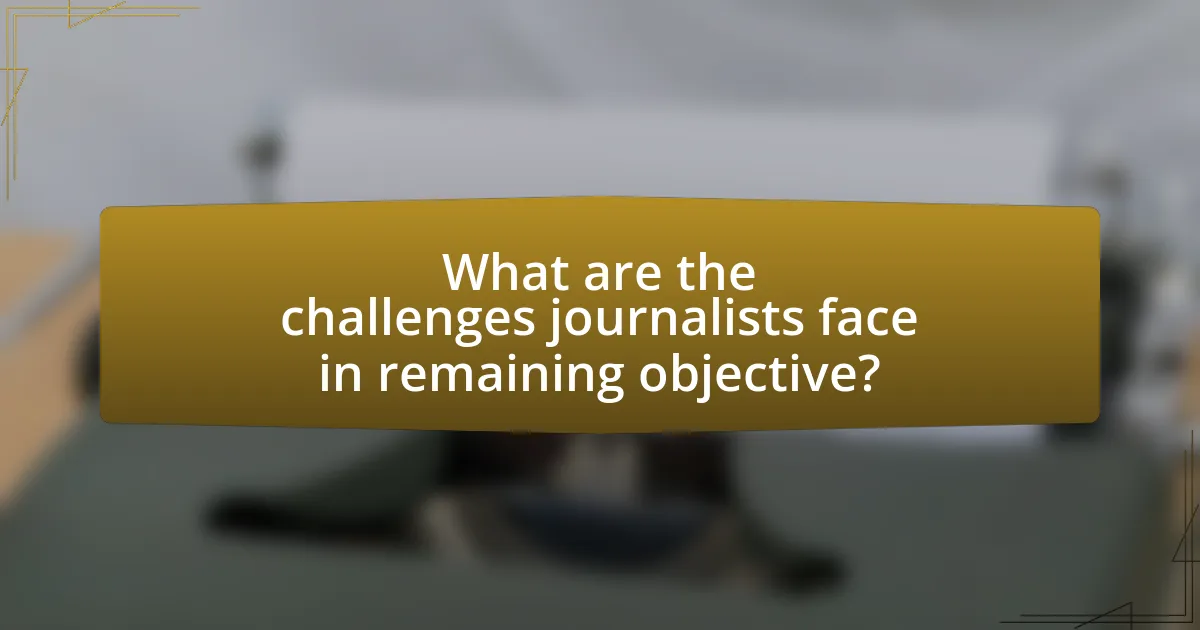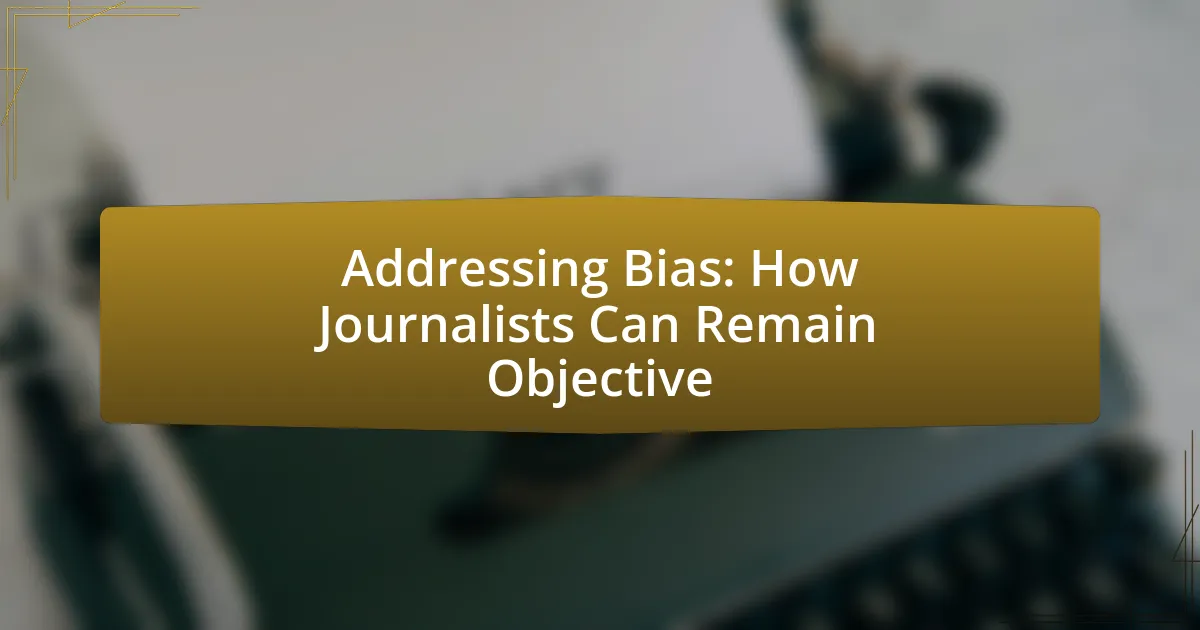Bias in journalism refers to the inclination or prejudice that affects the impartiality of news reporting, manifesting through selective reporting, framing, and language choices. This article explores the various types of bias, including confirmation, selection, and framing bias, and their impact on public perception and trust in media. It emphasizes the importance of objectivity for journalists, outlining strategies to mitigate bias, such as fact-checking, diversifying sources, and ongoing education. Additionally, the article discusses the challenges journalists face in maintaining objectivity, including personal beliefs, external pressures, and the influence of advertisers, while providing best practices for ensuring balanced reporting.

What is Bias in Journalism?
Bias in journalism refers to the inclination or prejudice that affects the impartiality of news reporting. This bias can manifest in various forms, such as selection bias, where certain stories are prioritized over others, or framing bias, where the presentation of information influences public perception. Research indicates that bias can significantly shape audience understanding and opinion, as evidenced by studies showing that media coverage can sway public attitudes on critical issues like elections and social policies. For instance, a study by the Pew Research Center found that 62% of Americans believe that news organizations favor one side in their reporting, highlighting the pervasive nature of bias in the media landscape.
How does bias manifest in journalistic practices?
Bias manifests in journalistic practices through selective reporting, framing, and language choices that influence audience perception. Journalists may prioritize certain stories or angles that align with their personal beliefs or the interests of their media outlet, leading to an incomplete or skewed representation of events. For example, a study by the Pew Research Center found that 62% of Americans believe news organizations favor one side in their coverage, indicating a widespread perception of bias. Additionally, the use of emotionally charged language can shape public opinion, as seen in the differing descriptions of protests by various media outlets, which can either portray them as peaceful demonstrations or violent riots, thus affecting audience interpretation.
What are the common types of bias found in journalism?
Common types of bias found in journalism include confirmation bias, selection bias, and framing bias. Confirmation bias occurs when journalists favor information that confirms their pre-existing beliefs, leading to a skewed representation of facts. Selection bias arises when certain stories or perspectives are chosen over others, often resulting in an incomplete narrative. Framing bias involves presenting information in a way that influences audience perception, such as emphasizing certain aspects of a story while downplaying others. These biases can significantly affect the objectivity of news reporting and the public’s understanding of events.
How can bias influence public perception of news?
Bias can significantly influence public perception of news by shaping the way information is presented and interpreted. When news outlets exhibit bias, they may selectively highlight certain facts while downplaying or omitting others, leading audiences to form skewed understandings of events. For instance, a study by the Pew Research Center found that 62% of Americans believe news organizations tend to favor one side, which can result in polarized views among the public. This selective reporting can reinforce existing beliefs and create echo chambers, where individuals are exposed primarily to viewpoints that align with their own, further distorting their perception of reality.
Why is objectivity important for journalists?
Objectivity is crucial for journalists because it ensures the accuracy and fairness of reporting. When journalists maintain objectivity, they provide balanced perspectives that allow audiences to form informed opinions based on facts rather than personal biases. Research indicates that objective reporting enhances credibility; for instance, a study by the Pew Research Center found that 66% of Americans believe that news organizations should strive for neutrality in their reporting. This commitment to objectivity fosters public trust and upholds the ethical standards of journalism, which are essential for a functioning democracy.
What role does objectivity play in maintaining credibility?
Objectivity is essential for maintaining credibility as it ensures that information is presented fairly and without bias. When journalists adhere to objective reporting, they provide a balanced view that allows audiences to form their own opinions based on facts rather than personal beliefs. Research indicates that audiences are more likely to trust news sources that demonstrate objectivity, as it fosters transparency and accountability. For instance, a study by the Pew Research Center found that 66% of Americans believe that news organizations should strive for neutrality in reporting. This highlights that objectivity not only enhances the perceived reliability of the information but also reinforces the journalist’s role as a trustworthy source in the media landscape.
How does objectivity affect audience trust in media?
Objectivity significantly enhances audience trust in media by providing unbiased and factual reporting. When journalists adhere to objective standards, they present information without personal bias, allowing audiences to form their own opinions based on facts rather than subjective interpretations. Research indicates that media outlets perceived as objective are more likely to gain credibility; for instance, a study by the Pew Research Center found that 62% of Americans believe that news organizations should strive for objectivity to maintain public trust. This correlation between objectivity and trust underscores the importance of impartial reporting in fostering a reliable media landscape.

What strategies can journalists use to address bias?
Journalists can address bias by implementing strategies such as fact-checking, diversifying sources, and employing editorial oversight. Fact-checking ensures that information is accurate and reduces the likelihood of presenting biased narratives. Diversifying sources allows journalists to capture a range of perspectives, which helps to balance reporting and mitigate bias. Editorial oversight, including peer reviews and editorial boards, can provide additional scrutiny to ensure that content adheres to ethical standards and is free from bias. These strategies are supported by research indicating that diverse reporting leads to more comprehensive and fair coverage, ultimately enhancing journalistic integrity.
How can journalists ensure balanced reporting?
Journalists can ensure balanced reporting by actively seeking diverse perspectives and verifying facts from multiple sources. This approach helps to mitigate bias and present a comprehensive view of the story. For instance, the American Press Institute emphasizes the importance of including voices from various stakeholders to reflect the complexity of issues, thereby enhancing the credibility of the reporting. Additionally, adhering to ethical guidelines, such as those outlined by the Society of Professional Journalists, reinforces the commitment to fairness and accuracy in journalism.
What techniques can be employed to verify sources?
Techniques to verify sources include cross-referencing information, checking the credibility of the source, and utilizing fact-checking organizations. Cross-referencing involves comparing information from multiple reputable sources to ensure consistency and accuracy. Checking the credibility of the source entails evaluating the author’s qualifications, the publication’s reputation, and the presence of citations or references. Fact-checking organizations, such as Snopes or FactCheck.org, provide independent verification of claims and can serve as reliable resources for confirming the authenticity of information. These methods collectively enhance the reliability of the information presented in journalism.
How can journalists present multiple viewpoints effectively?
Journalists can present multiple viewpoints effectively by ensuring balanced representation of diverse perspectives within their reporting. This involves conducting thorough research to identify various stakeholders and their opinions on the issue at hand, thereby providing a comprehensive view. For instance, a study by the Pew Research Center found that news articles that include quotes from multiple sources tend to be perceived as more credible and informative by audiences. By integrating these diverse voices, journalists not only enhance the richness of the narrative but also foster a more informed public discourse.
What role does training play in reducing bias?
Training plays a crucial role in reducing bias by equipping individuals with the skills and awareness necessary to recognize and mitigate their own biases. Through structured programs, participants learn about the various forms of bias, including implicit and explicit biases, and how these can affect decision-making and reporting. Research indicates that training can lead to significant improvements in bias recognition and reduction; for instance, a study published in the Journal of Personality and Social Psychology found that individuals who underwent bias training demonstrated a 30% decrease in biased decision-making compared to those who did not receive such training. This evidence underscores the effectiveness of training as a tool for fostering objectivity and fairness in journalism.
What types of training programs are available for journalists?
Various training programs are available for journalists, including workshops, online courses, and degree programs focused on media ethics, investigative reporting, and fact-checking. These programs aim to enhance skills in identifying and mitigating bias, ensuring objectivity in reporting. For instance, organizations like the Poynter Institute offer specialized courses on media literacy and ethical journalism, which are designed to help journalists navigate biases in their work. Additionally, universities provide degree programs that incorporate training on journalistic integrity and critical thinking, equipping journalists with the necessary tools to report accurately and fairly.
How can ongoing education help journalists stay objective?
Ongoing education helps journalists stay objective by providing them with updated knowledge and skills that enhance critical thinking and awareness of biases. Continuous training in media ethics, fact-checking, and diverse perspectives equips journalists to recognize their own biases and those present in the information they report. Research indicates that journalists who engage in regular professional development are better able to apply ethical standards and maintain impartiality, as evidenced by studies showing that training programs improve reporting accuracy and reduce biased narratives.

What are the challenges journalists face in remaining objective?
Journalists face several challenges in remaining objective, primarily due to personal biases, external pressures, and the influence of social media. Personal biases can stem from a journalist’s background, beliefs, and experiences, which may unconsciously affect their reporting. External pressures include the demands from editors, advertisers, and political affiliations that can skew the presentation of news. Additionally, the rise of social media has created an environment where sensationalism often trumps factual reporting, leading journalists to prioritize engagement over objectivity. According to a study by the Pew Research Center, 62% of journalists report feeling pressure to produce content quickly, which can compromise thoroughness and impartiality.
How do personal beliefs impact journalistic objectivity?
Personal beliefs significantly impact journalistic objectivity by influencing the selection of stories, framing of narratives, and interpretation of facts. Journalists may unconsciously prioritize information that aligns with their beliefs, leading to biased reporting. Research indicates that cognitive biases, such as confirmation bias, can cause journalists to favor sources and data that support their viewpoints while disregarding opposing perspectives. A study published in the Journal of Communication found that journalists’ political affiliations can shape their coverage, demonstrating that personal beliefs can distort the objectivity essential for fair reporting.
What strategies can journalists use to separate personal views from reporting?
Journalists can separate personal views from reporting by adhering to strict ethical guidelines and employing fact-checking methods. Ethical guidelines, such as those established by the Society of Professional Journalists, emphasize the importance of objectivity, accuracy, and fairness in reporting. By following these principles, journalists can maintain a clear distinction between their personal beliefs and the facts they present. Additionally, implementing rigorous fact-checking processes ensures that the information reported is verified and unbiased, further reinforcing the integrity of the reporting.
How can newsroom culture influence bias in reporting?
Newsroom culture significantly influences bias in reporting by shaping the values, priorities, and practices of journalists. A culture that prioritizes sensationalism or aligns with specific political ideologies can lead to selective coverage, framing issues in a way that supports those biases. For instance, studies have shown that news organizations with a strong partisan identity tend to report more favorably on issues aligned with their stance, which can skew public perception and understanding. Additionally, a lack of diversity within the newsroom can result in homogenous viewpoints, further entrenching biases in the reporting process.
What external pressures affect journalistic objectivity?
External pressures that affect journalistic objectivity include financial influences, political affiliations, and audience expectations. Financial influences arise when media organizations prioritize profit over impartial reporting, leading to sensationalism or biased coverage to attract viewers or readers. Political affiliations can compromise objectivity when journalists or their outlets align with specific political ideologies, resulting in slanted reporting that favors one side. Audience expectations also play a role, as journalists may cater to the beliefs and preferences of their audience, which can lead to confirmation bias and a lack of diverse perspectives in reporting. These factors collectively challenge the integrity of journalistic objectivity.
How do audience expectations shape journalistic practices?
Audience expectations significantly shape journalistic practices by influencing content selection, presentation style, and the overall approach to reporting. Journalists often tailor their work to meet the demands of their audience, which can lead to a focus on sensationalism or specific narratives that resonate with viewers. For instance, a study by the Pew Research Center found that 62% of Americans believe news organizations should prioritize accuracy over speed, indicating a clear expectation for reliable reporting. This expectation drives journalists to adopt fact-checking measures and thorough research processes to maintain credibility and trust. Additionally, audience feedback through social media platforms can prompt journalists to adjust their coverage, ensuring it aligns with public interest and sentiment.
What impact do advertisers and sponsors have on media bias?
Advertisers and sponsors significantly influence media bias by shaping content to align with their interests. Media outlets often rely on advertising revenue, which can lead to the prioritization of stories that favor sponsors or avoid topics that may alienate them. For instance, a study by the Pew Research Center found that 70% of journalists believe that advertising pressures can lead to biased reporting. This financial dependency creates a conflict of interest, where the need for funding can compromise journalistic integrity and objectivity.
What best practices can journalists adopt to maintain objectivity?
Journalists can maintain objectivity by adhering to best practices such as verifying facts, presenting multiple viewpoints, and avoiding conflicts of interest. Fact verification ensures that the information reported is accurate and reliable, which is essential for credibility. Presenting multiple viewpoints allows journalists to provide a balanced perspective, reflecting the diversity of opinions on an issue. Avoiding conflicts of interest prevents personal biases from influencing reporting, thereby enhancing impartiality. These practices are supported by the Society of Professional Journalists’ Code of Ethics, which emphasizes the importance of accuracy, fairness, and independence in journalism.
How can journalists implement fact-checking processes?
Journalists can implement fact-checking processes by establishing a systematic approach that includes verifying information through credible sources, cross-referencing data, and utilizing fact-checking tools. This method ensures accuracy and helps maintain objectivity in reporting. For instance, organizations like PolitiFact and FactCheck.org provide resources and databases that journalists can use to validate claims made in public discourse. By adhering to these practices, journalists can reduce bias and enhance the credibility of their work.
What role does transparency play in fostering trust with audiences?
Transparency is essential in fostering trust with audiences because it allows them to understand the motivations, processes, and potential biases behind the information presented. When journalists openly disclose their sources, methodologies, and any conflicts of interest, they create an environment where audiences feel informed and empowered to evaluate the credibility of the content. Research by the Pew Research Center indicates that 70% of Americans believe that transparency in reporting enhances trust in news organizations. This demonstrates that audiences are more likely to trust journalists who prioritize openness, as it aligns with their expectations for accountability and integrity in media.

Leave a Reply